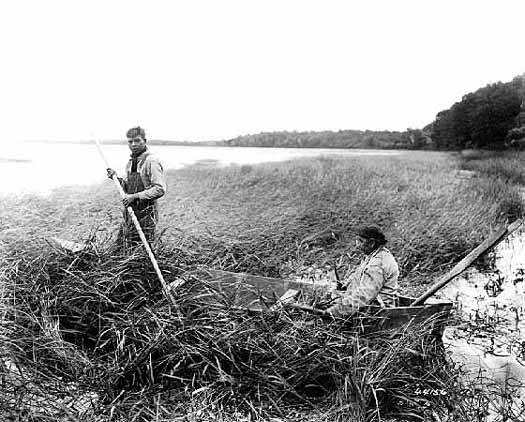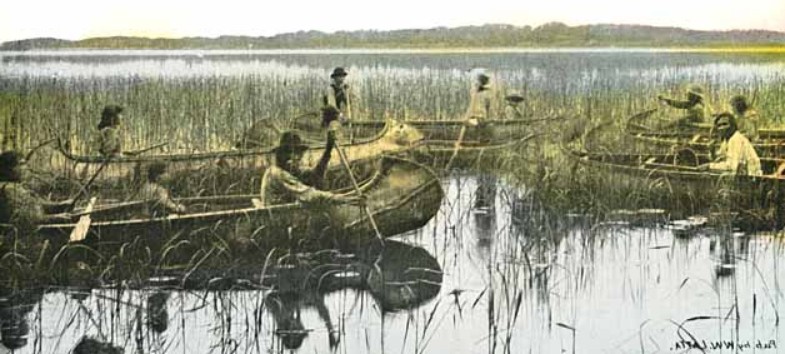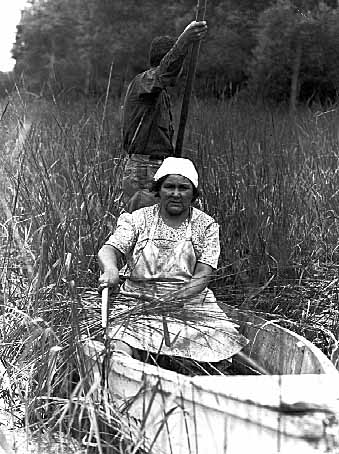
Manoomin: The Sacred Grain Sustaining the Soul of the Chippewa Nation
In the tranquil waters of the Great Lakes region, where the whispers of the wind carry the echoes of ancient songs, a timeless tradition unfolds each late summer. Here, amidst the verdant wetlands and shimmering lakes, the Chippewa (Ojibwe) people engage in a sacred practice that has sustained them physically, culturally, and spiritually for millennia: the harvesting of manoomin – wild rice (Zizania aquatica). More than just a food source, manoomin is a relative, a teacher, and the very embodiment of their enduring connection to the land and their ancestral ways.
For the Anishinaabeg, the collective name for the Ojibwe, Odawa, and Potawatomi peoples, manoomin is central to their creation stories and prophecies. According to oral traditions, their ancestors were guided by the Creator on a long migration from the East Coast to the Great Lakes, where they were told to settle in a place "where the food grows on water." That food was manoomin. This prophecy cemented wild rice’s status not just as a staple, but as a divine gift and a cornerstone of their identity.

“Manoomin isn’t just something we eat; it’s who we are,” explains Elder Margaret Kingbird, a revered knowledge keeper from the Leech Lake Band of Ojibwe, her voice soft but resonant with generations of wisdom. “It taught us how to live in balance with the earth. It taught us patience, respect, and gratitude. Without manoomin, we wouldn’t be the Anishinaabeg.”
The Dance of the Canoe: A Harvest of Respect
The harvesting season, typically from late August through September, is a highly anticipated time, marked by community gatherings and adherence to strict traditional protocols. Unlike commercial operations that might use mechanical harvesters, the Ojibwe practice remains largely unchanged for centuries, emphasizing sustainability and respect for the plant.
A typical harvesting crew consists of two people in a shallow-draft canoe, ideally a traditional birch bark canoe, though aluminum canoes are now common. One person, the poler, stands at the stern, expertly guiding the canoe through the dense rice beds using a long pole to avoid damaging the delicate roots. The other, the knocker, sits at the bow, holding two short, smooth cedar sticks, known as "knockers" or "ricing sticks."
“It’s a rhythm, a dance,” describes Michael Johnson, a younger harvester learning from his elders on the White Earth Reservation. “You use one stick to gently bend the stalks over the canoe, and the other to tap the ripe grains off. You don’t pull, you don’t rip. Just a gentle tap. Only the mature grains fall into the canoe. The rest stay on the stalk to ripen for another day, or to reseed.” This selective harvesting ensures that only about 10-20% of the rice is taken at any given pass, allowing for multiple harvests from the same bed and ensuring the plant’s long-term survival. This sustainable method is a stark contrast to destructive clear-cutting techniques sometimes employed by non-Indigenous commercial harvesters.
The sounds of the harvest are as much a part of the tradition as the sights: the soft swish of the pole through water, the gentle rustle of rice stalks, and the rhythmic tap-tap-tap of the knockers as the grains rain down into the bottom of the canoe. It’s a meditative process, connecting the harvesters to the natural world in a profound way.
From Water to Table: The Art of Processing
Once harvested, the manoomin undergoes a meticulous multi-step process before it’s ready for consumption. This labor-intensive transformation is itself a community affair, fostering intergenerational bonds and passing on vital knowledge.

- Drying (Wiinage): The freshly harvested rice, still containing high moisture, is spread out on tarps or mats in the sun to dry for several days. This prevents mildew and prepares it for the next stage.
- Parching (Aashkwaande): This is perhaps the most critical step. The rice is roasted over a slow, controlled fire in large iron kettles or rotating drums. Parching dries the kernels further, loosens the hulls, and imparts a distinctive nutty flavor. It also prevents the rice from sprouting, making it suitable for storage. The aroma of parching rice is a beloved scent across Ojibwe communities during harvest season.
- Threshing/Hulling (Bawa’igaan): Traditionally, the parched rice was placed in a shallow pit lined with canvas, and harvesters, often wearing new moccasins, would "dance" on it to separate the hull from the kernel. This rhythmic shuffling would break the brittle hulls without crushing the delicate rice grain. Today, some communities use mechanical hullers, but the traditional method is still practiced to honor the ancestors and for its ceremonial significance.
- Winnowing (Gaa-waasaagane): The final step involves tossing the hulled rice into the air using a shallow birch bark winnowing basket (noozhikaadan). The lighter chaff blows away in the wind, while the heavier, clean rice grains fall back into the basket. This process is repeated until the rice is perfectly clean.
“It’s hard work, no doubt,” says Brenda Bellanger, who has participated in the processing since she was a child. “But every step is an act of love. You’re not just cleaning rice; you’re honoring the gift, preparing it for your family and community. You can taste the tradition in every bite.”
Challenges on the Water: A Sacred Resource Under Threat
Despite its enduring significance, manoomin and the traditions surrounding it face numerous threats in the 21st century. Climate change is perhaps the most pressing, altering water levels and temperatures, which can severely impact rice growth. Droughts can dry up wetlands, while excessive rainfall or sudden temperature drops can damage emerging plants.
Pollution from industrial activities, agricultural runoff, and invasive species further endanger the fragile ecosystems where wild rice thrives. Invasive carp, for instance, can uproot rice plants, while non-native plants compete for light and nutrients.
“We’re fighting for its survival, just as it fought for ours,” states Robert Desjarlait, a tribal environmental advocate. “Pipelines, mining operations, encroaching development – they all threaten the water quality and habitat essential for manoomin. Our treaty rights to harvest are constantly challenged, but we will defend them because our culture depends on it.”
The commercialization of wild rice also poses a threat. Much of the "wild rice" sold in supermarkets is cultivated in paddies, often hybridized and machine-harvested, lacking the unique flavor, texture, and spiritual essence of true hand-harvested manoomin. This mislabeling not only misleads consumers but also undervalues the authentic product and the traditional practices that yield it.
Resilience and Revival: Nurturing the Future of Manoomin
In the face of these challenges, the Ojibwe people demonstrate remarkable resilience and a deep commitment to preserving their sacred grain. Tribal nations are actively engaged in conservation efforts, restoring degraded wetlands, monitoring water quality, and even cultivating wild rice in tribal nurseries to reseed depleted areas.
Educational initiatives are also vital. Tribal schools and cultural centers are teaching younger generations not just how to harvest and process manoomin, but also its history, spiritual significance, and the Ojibwe language terms associated with it. Community harvests are intentionally designed to be intergenerational, ensuring that elders can pass on their knowledge directly to youth.
“I remember coming out here with my grandpa when I was little,” says 16-year-old Anya Red Sky, carefully poling a canoe during a recent community harvest. “He taught me the songs, the prayers, the way to move the canoe so gently. Now, I’m helping teach my younger cousins. It’s important that we keep this going. It’s our heritage, our future.”
Legal battles are ongoing to assert and protect treaty-guaranteed harvesting rights, ensuring access to ancestral lands and waters. These legal fights are not just about resource access; they are about sovereignty, self-determination, and the right to practice their culture.
The annual manoomin harvest is more than just a seasonal activity; it is a powerful reaffirmation of Ojibwe identity and sovereignty. It is a time when the community comes together, not just to gather food, but to renew their vows to the land, to each other, and to the ancestors who guided them to "where the food grows on water."
As the sun sets over the rice beds, casting long shadows across the water, the last canoes glide back to shore, laden with the precious grain. The air is thick with the scent of woodsmoke and the promise of future feasts. The manoomin, the sacred grain, continues to sustain the Ojibwe soul, weaving together past, present, and future in a timeless tapestry of tradition, resilience, and profound respect for the natural world. In every kernel, in every shared meal, the spirit of the Chippewa Nation endures, nurtured by the very essence of the land that has always provided.


